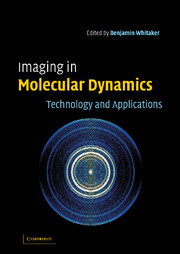Book contents
- Frontmatter
- Contents
- List of contributors
- Preface and acknowledgements
- List of abbreviations
- Part 1 Technology
- 1 Charged particle imaging in chemical dynamics: an historical perspective
- 2 Velocity map imaging: applications in molecular dynamics and experimental aspects
- 3 Reconstruction methods
- 4 Orientation and alignment
- 5 Time resolved cameras
- 6 3-D Imaging technique – observation of the three-dimensional product momentum distribution
- 7 Photoelectron and photoion imaging with femtosecond pump-probe time clocking
- Part 2 Applications
- Index
1 - Charged particle imaging in chemical dynamics: an historical perspective
Published online by Cambridge University Press: 07 August 2009
- Frontmatter
- Contents
- List of contributors
- Preface and acknowledgements
- List of abbreviations
- Part 1 Technology
- 1 Charged particle imaging in chemical dynamics: an historical perspective
- 2 Velocity map imaging: applications in molecular dynamics and experimental aspects
- 3 Reconstruction methods
- 4 Orientation and alignment
- 5 Time resolved cameras
- 6 3-D Imaging technique – observation of the three-dimensional product momentum distribution
- 7 Photoelectron and photoion imaging with femtosecond pump-probe time clocking
- Part 2 Applications
- Index
Summary
Introduction
Many problems in molecular dynamics demand the simultaneous measurement of a particle's speed and angular direction; the most demanding require the measurement of this velocity in coincidence with internal energy. Studies of molecular reactions, energy transfer processes, and photodissociation events can be understood completely only if the internal energies and velocities of all products are specified.
Consider the case of a monochromatic photodissociation that produces two fragments A and B. Even if the internal energy distributions of A and B were each measured separately, it would still be necessary to obtain information on their recoil speed in order to determine the internal energy of B given a selected level of A. Measurement of the coincident level of B would further require that only one parent molecule be dissociated in any particular experiment – a true coincidence experiment. Angular information is also desirable. In photodissociations, for example, the recoil angle with respect to the polarization vector of the dissociating light provides information about the transition moment in the parent molecule and the time-scale of dissociation. Because reactions in molecular beams have many of these same requirements, new techniques for simultaneous measurement of velocity and internal energy are quite important to molecular dynamics.
Many of the current techniques for making simultaneous velocity and internal energy measurements are based on imaging of product molecules or particles with microchannel plate (MCP) detectors.
- Type
- Chapter
- Information
- Imaging in Molecular DynamicsTechnology and Applications, pp. 3 - 19Publisher: Cambridge University PressPrint publication year: 2003



